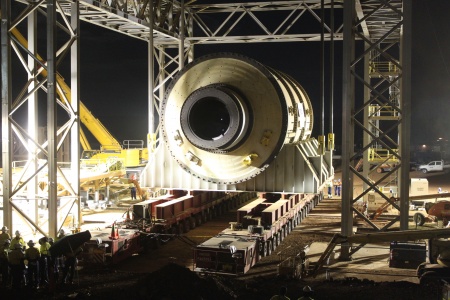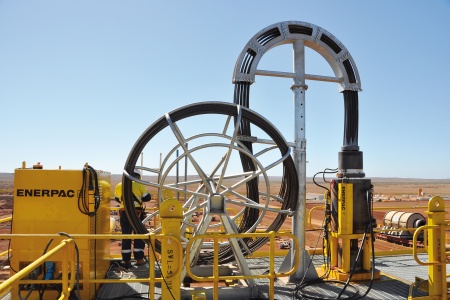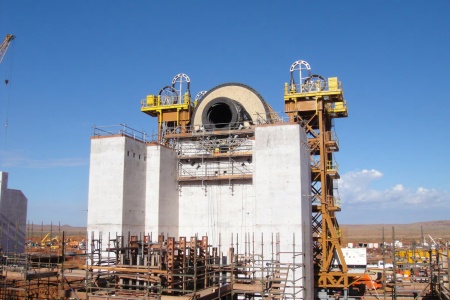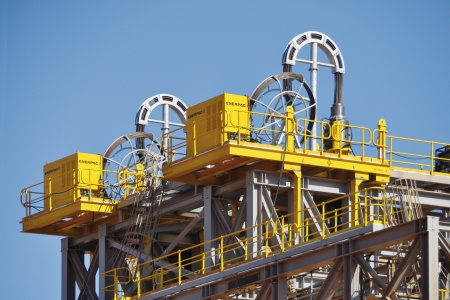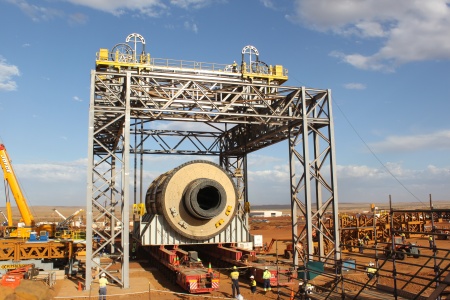Technology achievements abound as Enerpac Strand Lifting safely hoists massive iron ore mills from China
Customer:CITIC Pacific Mining and VDM Group
Location:Western Australia
An Enerpac Strand Lift system capable of safely positioning huge loads to accuracies within fractions of a millimeter is being employed by VDM Group in constructing Australia’s largest-ever magnetite mining and processing operation.
CITIC Pacific Mining’s $US4 billion Sino Iron Ore project in Western Australia involves 12 of the biggest iron ore processing mills ever built, which are manufactured in China and transported in sub-assembly form for precision positioning onto their bearings 21 metres above the ground.
It is the first time iron ore processing mills have been fabricated in a factory in China and transported internationally, travelling by sea and road for rapid assembly at a destination more than 7000 km distant and in the process achieving huge time savings over on-site fabrication.
The initial six pairs of 800 ton ball mills and 1400 tonne autogenous mills are being installed by VDM Group using the Enerpac precision lifting technology over an one year programme extending from January this year until end of January 2011, as the huge project builds up to an initial target capacity of 27,6 million tons a year from a resource of more than two billion tons of measured indicated and inferred magnetite ore. More mills may be added later as the site 100 km from Karratha grows to become one of the world’s biggest iron ore developments. The project, owned by China Metallurgical Company, will employ 10.000 workers to build it, 800 to run it and involve extensive technology transfer, with Chinese and Australian design teams developing the mills that will process the magnetite ore into fine concentrate and produce value-added products that will help pave the way for the magnetite industry in the state.
The Australian and International Enerpac Integrated Solutions team worked with CITIC Pacific previously in constructing the Beijing Olympics Birds Nest Stadium. The partnership employed Strand Lift technology that draws on Enerpac’s worldwide prestressing and post constant tensioning technology as well as heavy lifting expertise that was used in the lifting from the ocean floor of the 10.000 tonne Russian submarine Kursk.
Heavy Lifting Systems
The powerful PLC-controlled synchronous Strand Lift heavy lifting systems hoist loads of thousands of tonnes where access is restricted, overhead space is limited or maximum stability is required. Applications range from mining, energy and petroleum sites onshore and offshore, through to the placing of weapons systems in submarines, positioning machines in tunnels and erecting bridges and viaducts.
The Sino Iron Ore Strand Lift System specified by VDM Group for CITIC Pacific and MCC Mining involved four 444 ton 37 Strand, Strand Jacks, with Recoiler and Palm Tree Control Systems positioned on the prefabricated steel structures above the position to which the ball malls are delivered by road from the Cape Preston wharf to the mill site at Cape Preston concentrator area in Western Australia’s far northwest.
The mills travel overnight for several nights at about 1 km an hour on multi-wheel transporters before being placed beneath the Strand Lifting equipment for raising 6 metres clear of the transporters, then lowering 6 metres for positioning onto the mobile transporter that is driven laterally into position on rails after the multi-wheel transporter is removed.
The mobile transporter subsequently transports the mills laterally to a position adjacent to the foundation towers on which the trunnion bearings are located, where the Strand Lift System operating from another prefabricated jacking towers lifts and lowers them into their final position. The strand lift can raise and lower at speeds up to a metre every nine minutes, with one-person control of the many steps involved from a PLC screen synchronising the action of the jacks.
The jacks involve large capacity, hollow core hydraulic cylinders, dual locking cylinders and especially designed clamping wedges. The cluster of cylinders (each of which can be of up to 1000 ton lifting capacity) are positioned directly above the load to draw it securely upwards on multiple wire rope strands governed by an integral locking system.
The precision lifting system, suspended from a fixed, stable surrounding framework gives complete control at each stage of the lift, with the hydraulically actuated and PLC controlled lifting and locking system able to secure the load in any position.
“Accuracy is critical in all phases of the operation, none more so than the positioning of the huge mills onto their bearings. The lifts required very accurate and stable technology that could operate reliably in conditions including extreme heat, frequently well over 40 degree Celsius, as well as the possibility of frequent winds,” said Enerpac Integrated Solutions Manager Mr Colin Chapman. Mr Chapman and Enerpac Technical Support Engineer Ray Paasila assisted the engineer controlling the first Strand Lifts undertaken by the VDM Group.
“VDM Group invested a great deal of time and energy into fostering the teamwork that paid off during the lift. They travelled to Europe to train on the technology and worked closely with Enerpac and Enerpac Global Integrated Solutions Specialist, Mr Antonia Lopez Pasteur, who came to Australia for the first lift,” said Mr Chapman.
“The teamwork all paid off during the first lift, when, during the positioning over the bearings, we lowered the mill to within 0,6 mm of the target position as required by the mill manufacturer people on site. This is quite a marvelous achievement considering the mill is nearly 800 ton and we had to contend with winds we estimated at about 10m/s at the top of the mill foundation.
“Setting down the mill onto the thrust blocks was the most delicate part of the whole operation. There is only 0,5 mm clearance on each side between the thrust blocks and the groove in the trunnion of the mill.
“The CITIC Pacific and Monadelphous people involved asked us to adjust the mill position with four ancillary manual jacks by 0,1 mm at a time. VDM Group demonstrated tremendous skill by lowering the mill in steps as small as 0,2 mm as the mill approached the target position, far surpassing original specifications required. “Then the on-site team raised the trunnion bearings to make contact with the trunnions at both ends to support the mill. The cradles were then lowered down and then preparation was made to move the mobile transporter out of the way.
“It was an enormously intricate process, requiring extraordinary precision, preparation and teamwork. It was an outstanding achievement by all involved.” Strand Lifting (which originates from the concrete post tensioning principle) is particularly useful where loads need to be raised or lowered over long distances and where operators need maximum stability and precision control over the lifting process.
Each of the Strand Lifting elements employed on a project is suspended on steel cables above the load. The bundled steel cable (the strand) passes through the hydraulic cylinder of each Stand Lifting element. Each of these cylinders contains an integrated locking function, actuated remotely by synchronising PLC technology. After the cylinder’s initial extension, this clamps onto the cable as the cylinder retracts for its next cycle, then extends again to repeat the operation as many times as necessary for the job in hand.
By stroking the cylinder in and out while the grips are engaged, a lifting or lowering movement is achieved. A sophisticated software program synchronises the motion of the Strand Lifting elements and adjusts the motion to the loads per lifting point. This program can operate and control dozens of strand jacks simultaneously. During operation, all loads and anchor positions are displayed on the screen of the control unit.
“Because the multiple jacks can be moved in unison and with great precision, heavy structures can be assembled at ground level (with increased safety and reduced cost)and then lifted into position, rather than having to be built in the air. Traditional cranes and other lifting methods cannot provide this level of precision,” says Mr Chapman, who has been involved in some of Australia’s major industrial and infrastructure projects, including pipeline, resources loader, ports, petroleum, heavy lifting and materials handling projects. Because the strand lifting cylinders are directly over the lift points of the load, it not only gives maximum stability, but also allows the full lifting force to be employed, rather than being reduced by being employed from an offset position on the end of a lifting beam or boom). Designed to complement cranes and other lifting systems, the maximum lifting capacity of the strand system is determined by strand capacity rather than the abundant capacity of the hydraulic cylinders, which are types already employed worldwide with outstanding reliability, says Colin Chapman. “Theoretically any number of strand jacks can be used simultaneously to achieve unlimited lifting capacity, with computer-control to keep the motion of all jacks synchronised. “But in practice, if we were using 40 of the largest jacks used in Australia to date (each of about 444 ton), with a safety factor of 2,5 to 1, loads of more than 17.000 ton can be lifted with utmost precision and safety.
Enerpac Integrated Solutions projects globally range from lifting of entire buildings and bridges (including the Golden Gate Bridge) to splitting of mining draglines for maintenance and construction of offshore oil rigs.
Recent projects include construction of the world’s highest viaduct, the Millau viaduct in Southern France, which at 300 metres (984 feet) is the highest road bridge in the world, twice as high as the top of the Sydney Harbour Bridge and taller than the Eiffel Tower.
CITIC Pacific's Sino Iron Project
CITIC Pacific Mining’s Sino Iron project is a world class, large-scale magnetite iron ore project, the first of its kind in Western Australia. It is bringing innovative, new mining processes to this country and is the first iron ore project to include large scale downstream processing.
The company says the project will draw on the expertise and skills in magnetite processing from Chinese and other world leaders in this field, providing an excellent opportunity for Australia to benefit from exposure to international skills and processing technology.
The Sino Iron project will be a highly technical, value-adding operation requiring significant processing and transport infrastructure.
The project has access to over two billion tonnes of measured indicated and inferred magnetite ore and, when operational, will be one of the world’s largest mines. It will process produce 27,6 million ton a year of a mix of pellets and concentrate.
The mine’s end product – magnetite, in concentrate and pellets – is an important commodity as it is one of the raw materials used to make steel. In the conversion process, significantly less carbon dioxide is produced than with other materials, making magnetite increasingly desirable in this era of environmental awareness. It is estimated that CITIC Pacific Mining’s Sino Iron project will add nearly AU$75 billion in revenue to the Australian economy over the next 25 years.
Spending on operations is expected to exceed AU$30 billion over the current life of the project and it will generate export revenue of at least AU$3 billion a year. Successful implementation of this project could also facilitate developments of magnetite iron ore projects and major gas projects in the immediate vicinity.
The project also represents a significant linkage with China, fostering closer ties between the governments of Western Australia and China, which in turn could trigger interest in other direct investment from China into the State or nationwide.
